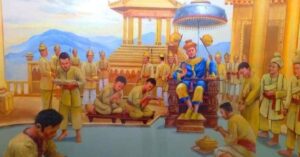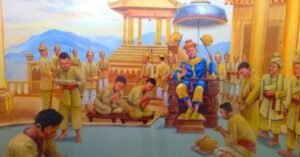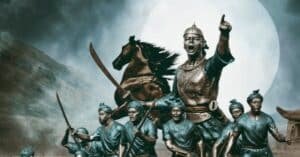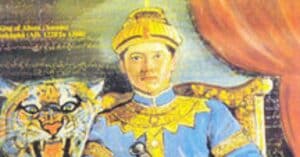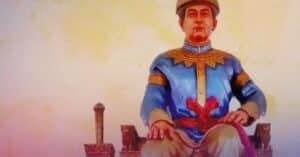The rule of numerous Ahom Kings glorifies the history of Assam. The Ahom dynasty ruled Assam from 1228 AD to 1826 AD. Six decades of Ahom rule is one of the brightest periods of Assam’s history. A successive generation of Ahom kings defeated numerous hill tribes and Mughal invaders to make Assam a powerful state. Besides, the generations of Ahom kings contributed economic and cultural development of Assam. Here is the selected list of Ahom King (Part 2):
For Part 1 of the list of Ahom kings, read this blog post.
Udayaditya Singha
Udayaditya Singha was the 21st Ahom king who ruled from 1669 CE to 1673 CE. The Mughal-Ahom hostilities at the climax when Udayaditya Singha took over as king. The Mughal army, under the command of Rajput king Raja Ram Singh, was making efforts to capture the military outpost of Guwahati. Meanwhile, the Ahom forces, led by Lachit Borphukan and Atan Burhagohain, were in Guwahati to check any Mughal advance.
Ram Singh sent a proposal to King Udayaditya Singha, that if the Ahoms surrendered the garrison of Guwahati in favour of the Mughals, he gave his word that the Mughals would respect the boundary of the Ahom kingdom and would not make any advance further Guwahati. Udayaditya Singha, in consultation with Atan Burhagohain, directed the commanders to bring the war to the Mughals and push them beyond Guwahati. So, the main battle of Saraighat was fought during his time in 1671 CE.
The Koch Kingdom, The Garos and the Raja of Rani joined the Ahoms. The Ahoms under Lachit Barphukan defeated the Mughals in the famous battle of Saraighat near Guwahati. Lachit became an Assamese national hero. The Mughal forces were chased till Manas River and the Ahoms retained their possessions of Guwahati and Kamrup.
The later part of his reign was characterized by the failure of the military expedition against the Dafla tribes and the influence of Paramananda Sannyasi, a saintly figure from Brindaban, over Udayaditya Singha. Under his influence, King Udayaditya summoned the twelve Vaishnav Mahantas or religious heads and asked them to become disciples of Paramananda Sannyasi. The Vaishnav Mahantas were thrown into prison because they refused the king’s order. These events led to his deposition and execution by his council of ministers.
Years of Turbulence
Between the death of Chakradhvaj (1669) and the accession of Gadadhar (1681), in a short span of 12 years, there had been as many as 7 kings and not one of them died a natural death. King Ramdhwaj Singha and Suhung were deposed and killed within two years. King Gibar Singha lasted only three weeks. Such was the pity affairs of the kingdom. To make matters worse, Guwahati was surrendered by Laluksola Borphukan to the Mughals.
Gadadhar Singha
Choapha Supatpha or Swargadeo Gadadhar Singha was the 29th Ahom king who ruled from 1681 CE to 1696 CE. Gadapani, son of Gobar Raja, assumed the title of Gadadhar on accession in 1681 and with it came to an end the era of incompetent and fratricidal princes as did that of internal dissensions. He became the founder of a long line of kings whose reign ended only with the advent of the Burmese, followed by that of the British. The historians’ verdict is that the Ahom rule was at its zenith for a century, from the reign of Gadadhar (1681-96) to the reign of Lakshmi Singh (1769-80).
Gadadhar made his capital at Barkola. From day one he was preparing his army to oust the Muslims from Gauhati, which fell to the Ahoms in 1682 and made their forts at Bansbari and Kajali. The Muslims were pushed as far west as the Manas which thence was accepted as the border by two sides. Incidentally, this was the last Ahom-Mughal war, which yielded a huge booty to the Ahoms, including cannons of all sizes.
Persecution of the Vaishnavas
Gadadhar Singha, a ruler, had a bad part in his rule when he mistreated Vaishnavas, followers of a religious group founded by Srimanta Sankardev. He was worried that if the Vaishnavites didn’t do certain tasks or ate certain foods as their religion dictated, they wouldn’t be strong enough to defend the kingdom. So, he punished them harshly, deporting them and even ordering some to be killed. He stopped the cruelty only when it became too extreme.
Achievements of Gadadhar Singha
A patron of Sakta Hinduism, the Umananda temple on the Peacock island opposite Gauhati was built under his auspices. He built the Dhodar Ali, Aka Ali, etc. and two stone bridges. He ordered a detailed land survey of the country, which he had heard and learnt about while in hiding in lower Assam. The surveyors were imported from Koch Bihar and Bengal. It was the system which the British later introduced in Assam.
Assessment: Gadadhar Singh
To begin with, he was a victim of several conspiracies but he dealt with them successfully, even if ruthlessly. Within a short span of 15 years, he restored to the monarchy the supreme power which had slipped into the hands of the nobles because of continued dissensions among the royalty for over a decade before his accession (1681). His rule marks the commencement of the ascent of the Ahom rule to its zenith from the nadir it had touched during the Muslim invasions in the earlier years of the 17th century. Starting with his rule, the Ahoms reigned supreme for 100 years when its decline commenced in the last quarter of the 18th century.
Rudra Singha
Sukhrungphaa or Swargadeo Rudra Singha was the 30th Ahom king who ruled from 1696 CE to 1714 CE. He was the king who put an end to the persecution of the Vaishnavas, under the only condition that they move their headquarters to the Majuli Island. The Auniati Gosain was recalled from exile and the king appointed him as his spiritual preceptor. The persecution of the Sudra Medhis also ceased but the Brahmins were forbidden to bend their knees to them and they were required to wear as their distinctive badge, a small earthen pot hanging from a string around the neck.
He imported from Koch Bihar an artisan, Ghan Shyam, skilled in building brick palaces and other big houses and had many such structures raised in and around Rangpur (near Sibsagar) and Charaideo.
Assessment of Ahom King Rudra Singh
Rudra Singh, though illiterate, possessed a sharp and retentive memory and exceptional intelligence 32 and is regarded by many as the greatest of the Ahom kings. A man of religious leanings, he adopted Hinduism. He studied foreign customs and adopted some for his court. He was the first to establish several schools for Brahmins to impart necessary knowledge of religious practices and rituals; and even sent some suitable Brahmin boys to the great centres of learning in Bengal and beyond.
He ensured the completion of the land survey commenced by Gadadhar in the Sibsagar and Nowgong districts.
He is said to have established extensive trade relations with Tibet. Abandoning to an extent the isolationist policy of his predecessors he encouraged intercourse with some states in other parts of India and sent his envoys to visit their rulers. The king was cremated at his death on Mani Karneswar Hill, for he willed so; and not buried in a vault at Charaideo as was customary among the Ahom Royalty.
Siva Singha
Siva Singha was the 31st Ahom king who ruled from 1714 CE to 1744 CE. He was the eldest of the five sons of the four queens of Rudra Singh. Being a strong follower of Saktaism, the king became a disciple of Krishnaram Bhattacharjee whom he appointed the Gosain (head priest) of Kamakhya Temple.
Vaishnavas Humiliated
The king and his senior queen were coming under the increasing influence of the Sakta (Brahmin) priests. Hearing that Vaishnava Mahants (=Gosains; high priests) refused to worship Durga, she ordered the Moamaria Gosain and several other Vaishnava Gosains to be brought to the Sakta shrine where the sacrifices were being offered and caused the distinguishing marks of the Sakta sect to be smeared with the blood of the animals on their foreheads. The Vaishnavites had suffered oppression under Gadadhar Singh but the Queen’s treatment crossed all limits. The Moamarias never forgave or forgot this insult to their spiritual leader and this humiliation supplied the seed that sprouted into a violent (Moamaria) rebellion half a century later.
Parramatta Singha
Sunenphaa or Parramatta Singha was the 32nd ahom king who ruled between 1744 CE to 1751 CE. He succeeded his elder brother Swargadeo Siva Singha, as the king of Ahom Kingdom. His reign of seven years was peaceful and prosperous. He constructed numerous buildings and temples. The most famous of his buildings was the Rang Ghar, which is also considered the oldest amphitheatre in Asia.
Rajeswar Singha
Rajeswar Singha was the 32nd ahom king who ruled between 1751 CE to 1769 CE. He was an able man but lazy and pleasure-loving by nature, he left governance to Bar Barua Kirti Chandra Gendhela who soon became unpopular for his overbearing ways. Again, he was the king who got several buranjis destroyed as mentioned earlier, inflicting irreparable damage to the history of Assam. Some nobles plotted to kill him, but he escaped with some wounds.
Assessment of Rajeshwar Singh
He took sharan (religious undertaking) from a relative of the Parbatiya Gosain. Though indolent, he was a capable ruler and during his reign, his people enjoyed internal peace and freedom from external aggression. But there was the flip side to the idyll. The martial spirit of the war like Ahoms was on the vane as it was for the first time that many commanders refused to take the field during the Burmese campaign. Again, the Sakta-Vaishnava strife was weakening the kingdom. But more worrisome for the integrity of the kingdom was the seething unrest among the Moamarias led by their Gosain, who was nurturing his psychological wounds caused by the past humiliations.
All necessary conditions for the down-slope journey of a once-mighty polity of ahom empire were present. It was no surprise that trouble started for the next king.
Lakshmi Singha
Lakshmi Singha was the 33rd ahom king who ruled between 1769 CE to 1780 CE. Lakshmi Singh, Rudra Singh’s younger son, ascended the throne in the face of opposition from his senior nobles. As the Parbatiya Gosain refused to recognise him on grounds of his illegitimacy, he hit back by importing a new priest from Bengal, also a Sakta, and the first of the Na Gosains.
Moamoria Revolt
Bar Barua had become very powerful, and as arrogant and vengeful. He was going in the Royal Barge with the king when they passed by the Moamari Gosain. The Gosain saluted the king only and he ignored Bar Barua and hurled abuses at him. Soon thereafter, the Chief of the Moran tribe”, Nahar incurred the wrath of the haughty Bar Barua for a minor lapse, who ordered his ears cut off. Chief Nahar, the disciple of the Moamaria Gosain, complained to him and it proved the proverbial last straw. The Gosain collected his followers, appointed his son, Bangan, to lead them, and entered Namrup. A large number of people, mainly the Morans and Kacharis, received him enthusiastically and became his disciples. The first Moamoria uprising had truly begun. The king sent his men to arrest Bangan but they were all put to death by the rebels, who then advanced to Tipam. The first action took place on the banks of the Dibru, and then the two sides got into entrenchments and were merely facing each other for months.
An insurgent force under Ragha, a Moran styling himself ‘Bar Barua’, advanced down the banks of the Brahmaputra in October 1769, defeating the Royalists in many battles. When they arrived at Rangpur, the king was already at Sonari Nagar, on the way to Gauhati. He was chased, brought back to the capital, and confined to Jay Sagar Temple. Several nobles and chiefs were put to death.
Ramakant Became The King During the Moamoria Uprising
The rebels wanted Bangan to be the king, but his father Moamaria Gosain, rejected the offer and raised Ragha’s son, Ramakant to the throne. Various rebel leaders were rewarded with high offices and took possession of the houses of officers they had supplanted. Coins were struck in Ramakant’s name, dated Saka 1691 (AD 1769), but real power rested with Ragha, the new Bar Barua. The upper Assam Gosains were made to acknowledge the spiritual supremacy of Moamaria Gosain.
For months things were easy for rebels and they lowered their guard and then the Royalists struck in April 1770. Ragha was killed but Ramakant escaped.
Lakshmi Singh Became the King Again
The royalist forces restored the king to the throne and let loose a reign of terror against the Moamarias. Their Gosain was impaled and killed as were the rebel leaders including Ramakant.
The excesses led to a fresh uprising by the Chungis of Namrup, later joined by the Moamarias. The two jointly fought the Royalists on the banks of the Desang. Losing the battle, the rebels disappeared into the jungles and for months, continued with guerrilla actions. For years then, it was all quiet till early 1775, when the dismissed Kalita Phukan rebelled and declared himself the king at Tamulbari on the Lohit-only to be captured and killed. Subsequently, there were local revolts in 1775 and 1779 in Lohit and Sadiya areas respectively, which were quelled. The king died in 1780.
Gaurinath Singha
Gaurinath Singha was the 35th ahom king who ruled between 1780 CE to 1795 CE. He became the disciple of Ramananda Acharyya. At the very start, he caused the other princes of the blood to be mutilated or disfigured, rendering them ineligible for the succession. The Ahom law barred a person with the slightest disability from being an aspirant to the throne.
A bitter enemy of the Moamarias, the king’s oppressive measures were too harsh, goading them to a fresh revolt in April 1782. Burha Gohain repelled the rebels, but wisely advised conciliation towards them. The king rejected the sage’s advice and instead, acting on the advice of the new Bar Barua ordered the wholesale extermination of the Moamarias.
Consequently, there was a serious revolt by Moamarias in 1786 on the north bank. An expedition sent to quell it was cut up. Forces of Rani, Luka and Beltola joined the fray on the side of the Royalists and were sent to Majuli. The rebels responded by crossing the Lohit at Gormur and captured Gormur Satra at Majuli. Then they marched against the Gauhati levies and put them to flight. Panicked, the remnants of the Royalists on the north bank recrossed the Lohit and Dihing and joined the Burha Gohain at Sonari who later joined the king at Rangpur. Bar Phukan held at Gauhati. The Moamarias had laid waste to the country and surrounded Rangpur. After failing to take it, they fell back to Majuli.
Gaurinath sent out desperate appeals for help to Bar Phukan at Gauhati as well as to Manipuri, Kachari and Jaintia Rajas. The Moamarias again appeared at the gates of Rangpur. The king fled to Gauhati and Burha Gohain stayed back to stem the tide. Before any help could reach him, the rebels captured Garhgaon after defeating the Royalists. Burha Gohain held out at Sibsagar till
February 1789, when he was driven back to Gauri Sagar. In April 1790, he constructed fortified defences at Jorhat.
Losing heart, the people could have easily gone over to the Moamarias but for the untiring exertions of Burha Gohain. The other restraining factor was that life under the rebels was even worse, what with daily killings, lootings and burning ‘jungle rule’, where even the highest castes were reduced to eating the flesh of cows, jackals, etc. Famine was so severe that many abandoned their children.
Petty Rajas Emerge All Over
The Centre (of Ahom Power) did not hold any more. Consequently, several petty kings cropped up in the region. Manipuri Raja was the only one to respond to the appeal for help, marching with 500 horses and 4000 feet to attack Rangpur. Manipuri fighters failed to change the status quo.
Burha Gohain, holding on to his position, built an embankment outside Rangpur, in 1792. On the other hand, Krishna Narayan, son of Darrang Raja, who had been put to death by Gaurinath, was determined to claim his inheritance. Collecting a force of Hindustanis and other mercenaries, popularly called Burkandazes, proclaimed himself Raja of Darrang. He even annexed the northern part of Kamrup, including north Gauhati.
The British Enters Assam
Gaurinath Singha appealed for help to Lord Cornwallis through the collector of Rangpur in north Bengal. The Governor General held that as the trouble had been created by gangs of marauders from British territory, the British Government was morally bound to restore the situation. So, in 1792 AD, he despatched Capt T. Welsh with six companies of 60 sepoys each.
Capt Welsh reaches Gauhati and takes it over, enabling Gaurinath to make a royal entry. Krishna Narayan and his forces fled to Bhutan. In 1794, the British troops moved to Koliabar to proceed against the Moamoria rebels. Gaurinath writes to the Governor General, requesting that he be allowed to use the services of Welsh and his men against the annual payment of Rs. 3,00,000 and their maintenance.
In February 1794, Welsh and his men joined Burha Gohain at Rangpur. The rebels fled. Following a policy of no interference, the British Governor ordered the return of the Welsh by 1 July 1794. Gaurinath returned to Jorhat and Moamaria rebels were back again at Rangpur. They dismissed or beheaded all officers appointed by Welsh.
In 1794, Sadiya was taken over by Khamtis and reduced the local Assamese to slavery. Their chief assumed the title of Sadiya Khowa Gohain. Gaurinath died in December 1794 and Kina Ram, a descendant of Gadadhar, was made the king.
Evaluation of King Gaurinath Singh
He was “most incompetent, blood-thirsty, disreputable and cowardly of all the Ahom Kings”. Always moving with an executioner, he ordered the victim beheaded on the slightest provocation. A little more imaginative king could not only have averted the Moamoria revolt but also won over the rebels through conciliation.
FAQs Regarding Ahom Kings
Q: Which Ahom King was cremated in Mani Karneswar Hill, not buried in Charaideo Maidam?
A: King Rudra Singha was cremated in Mani Karneswar Hill
Q: Which is the oldest amphitheatre in Asia?
A: Rang-ghar in Assam, built by Parramatta Singha is the oldest amphitheatre in Asia
Q: Who was the first Ahom king from the Tungkhungia clan?
A: Gobar Singha was the first king from the Tungkhungia line of the Ahom dynasty,


